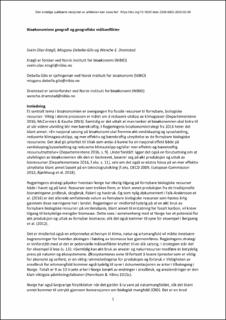| dc.contributor.author | Krøgli, Svein Olav | |
| dc.contributor.author | Debella-Gilo, Misganu | |
| dc.contributor.author | Dramstad, Wenche | |
| dc.date.accessioned | 2021-03-24T11:30:56Z | |
| dc.date.available | 2021-03-24T11:30:56Z | |
| dc.date.created | 2020-10-13T09:18:43Z | |
| dc.date.issued | 2020-09-08 | |
| dc.identifier.citation | Kart og plan. 2020, 113 (2), 104-120. | en_US |
| dc.identifier.issn | 0047-3278 | |
| dc.identifier.uri | https://hdl.handle.net/11250/2735272 | |
| dc.description.abstract | The development of a new bioeconomy implies an increased need for renewable biological resources. This means that more of the existing biomass will be har vested and a larger land area is likely to be utilized. While it is widely acknowl edged that this increased harvest and production must be sustainable, it must also be acknowledged that there are some potential challenges. For example, there may be different aims targeting the same area. To meet this challenge in an informed approach, we argue that geographical data and spatial analyses are key. We exemplify this through a study in which we utilize the spatial distribution of produced biomass from agriculture and forestry, together with the location of threatened species from the Norwegian Red List of Species. In our analyses we demonstrate that there is a spatial overlap between the most productive land for forestry and agriculture. At the same time, a high occurrence of threatened spe cies is also found in these areas. We conclude that analysing the geography of conflicting aims is important. It documents the importance of spatial data, and findings from this type of analyses need to be included in bioeconomy decision making. | en_US |
| dc.language.iso | nob | en_US |
| dc.publisher | Idunn | en_US |
| dc.title | Bioøkonomiens geografi og geografiske målkonflikter | en_US |
| dc.title.alternative | The geography of the bioeconomy and conflicting aims | en_US |
| dc.type | Peer reviewed | en_US |
| dc.type | Journal article | en_US |
| dc.description.version | acceptedVersion | en_US |
| dc.source.pagenumber | 104-120 | en_US |
| dc.source.volume | 113 | en_US |
| dc.source.journal | Kart og plan | en_US |
| dc.source.issue | 2 | en_US |
| dc.identifier.doi | 10.18261/issn.2535-6003-2020-02-04 | |
| dc.identifier.cristin | 1839067 | |
| dc.relation.project | Norges forskningsråd: 244608 | en_US |
| cristin.ispublished | true | |
| cristin.fulltext | postprint | |
| cristin.qualitycode | 1 | |
